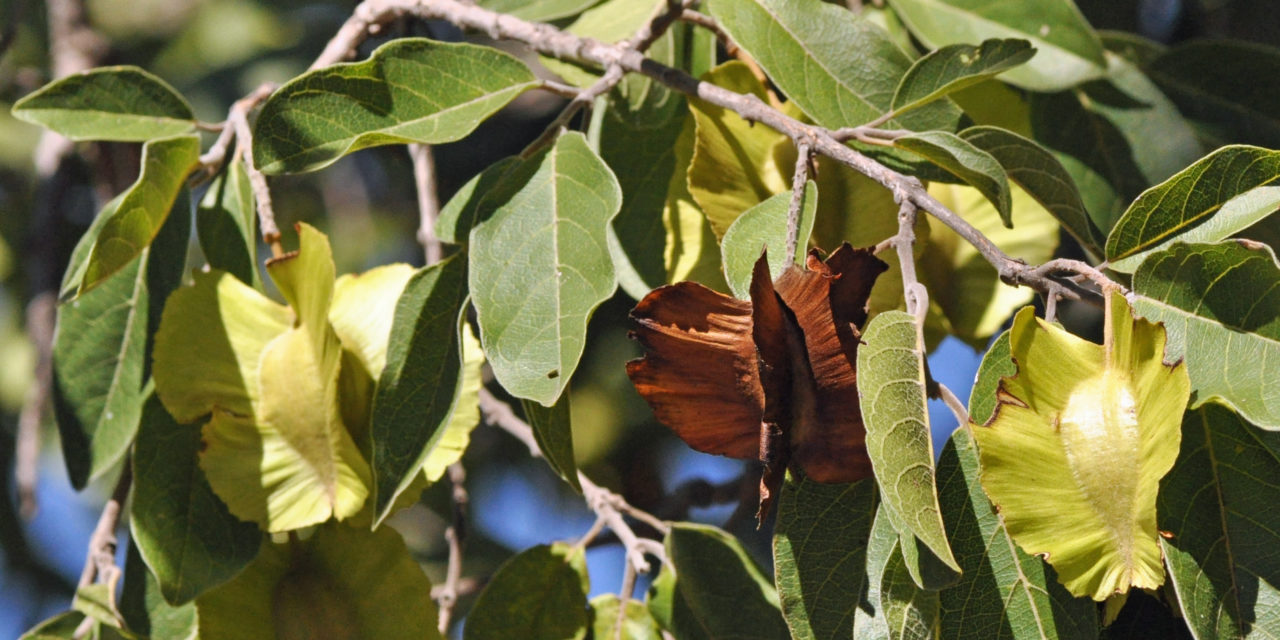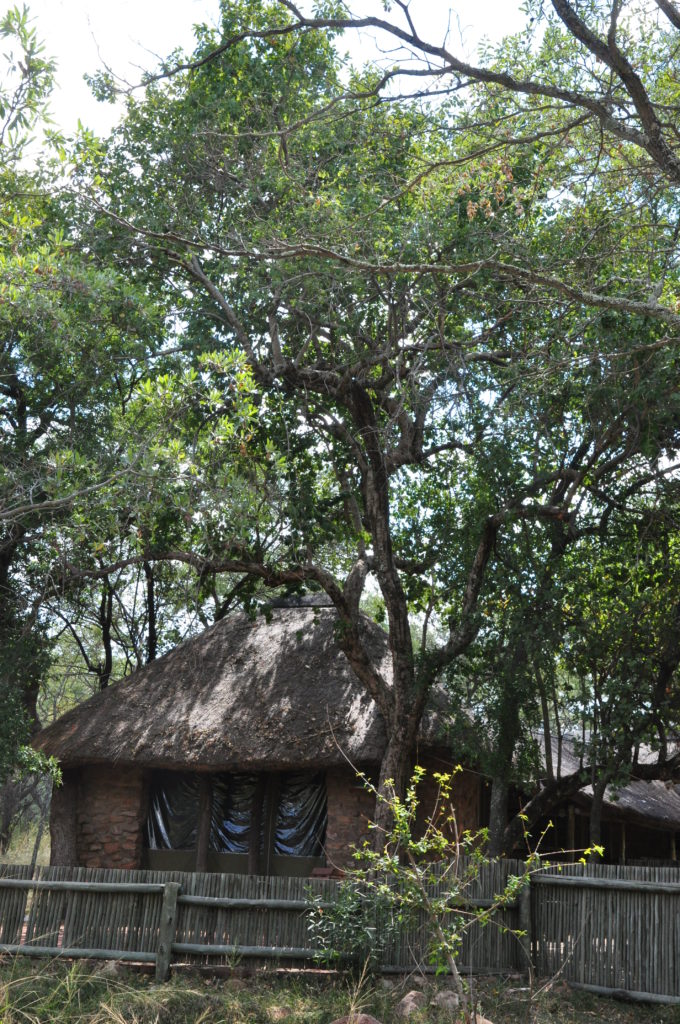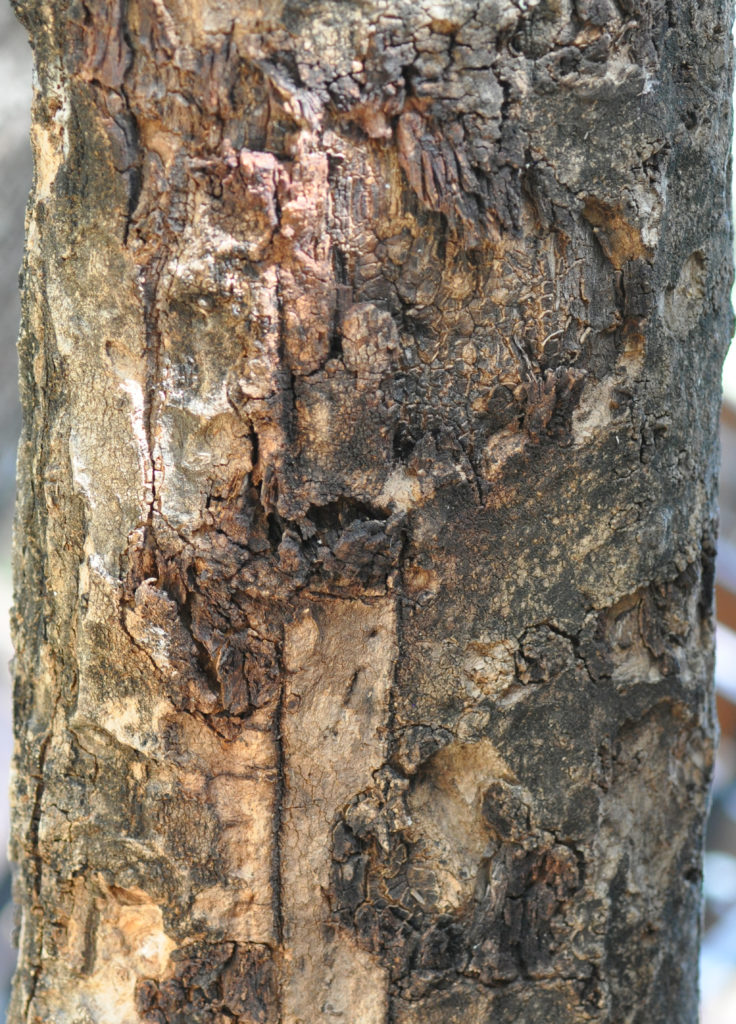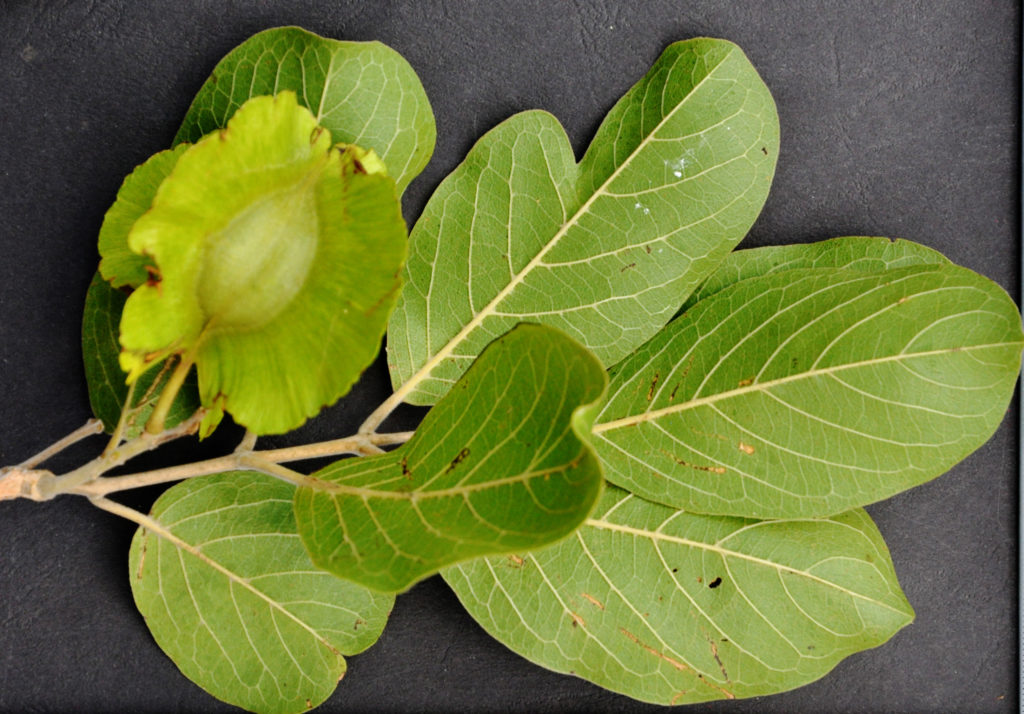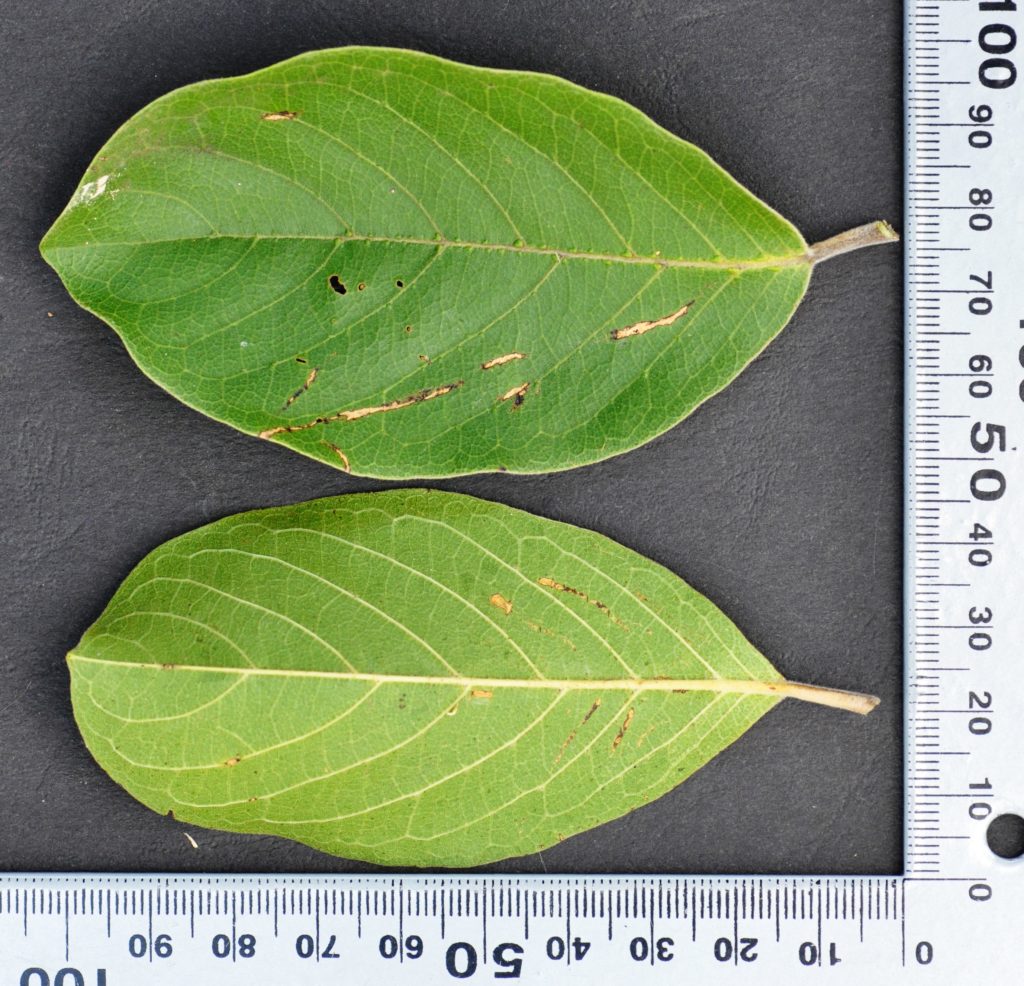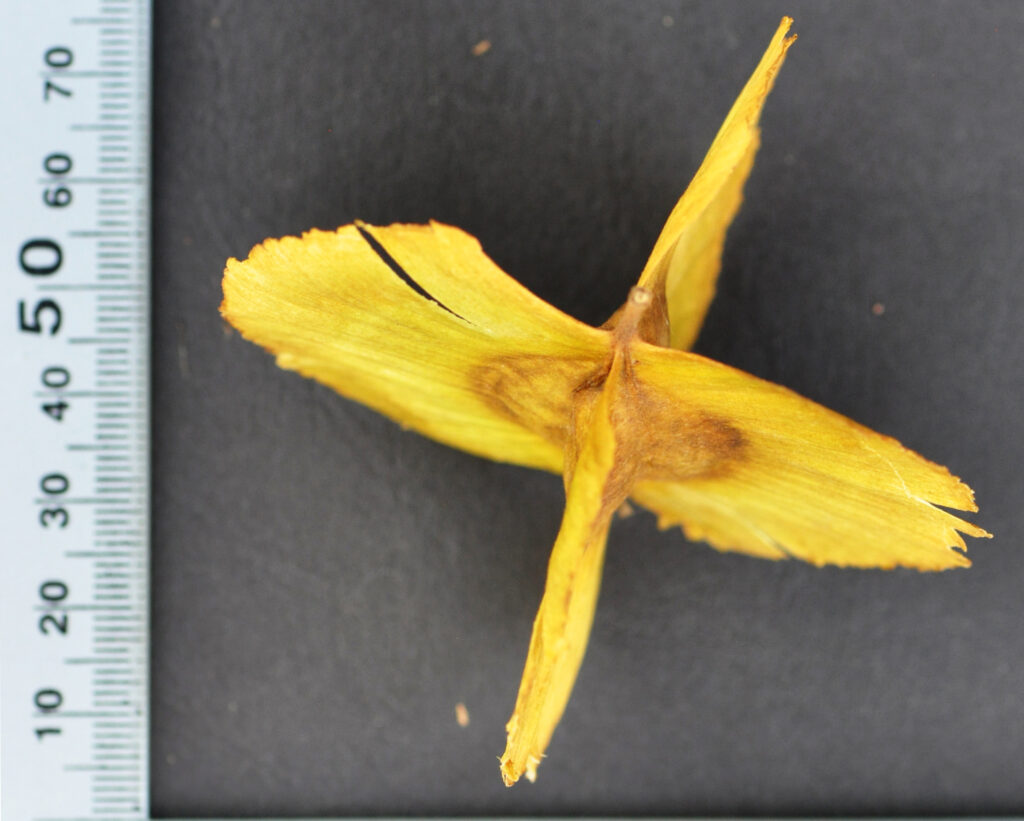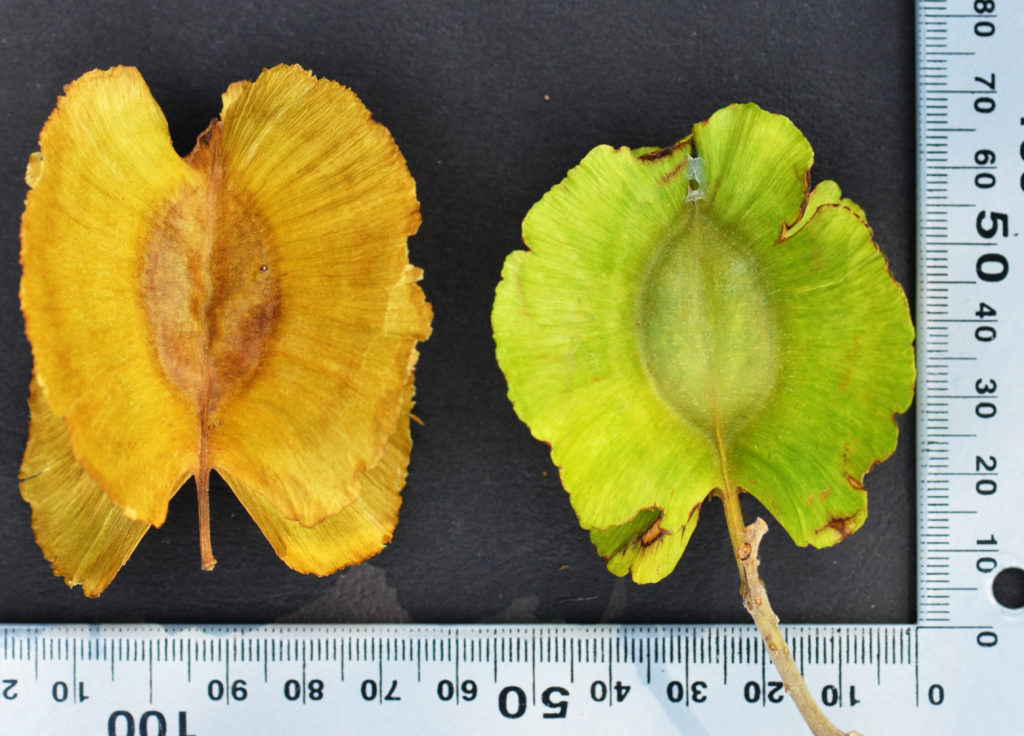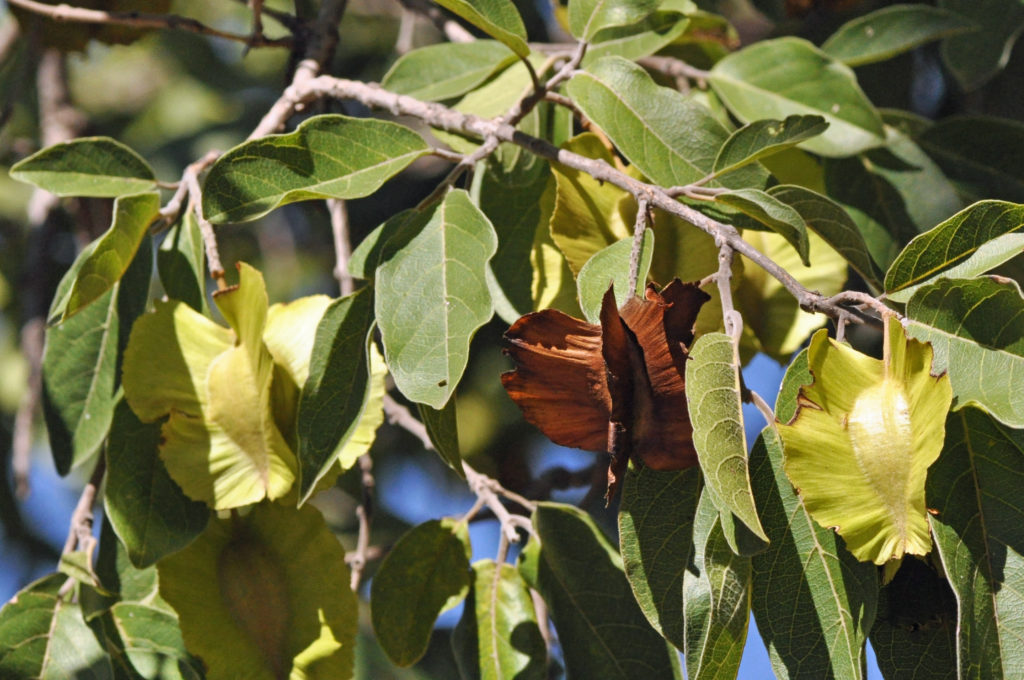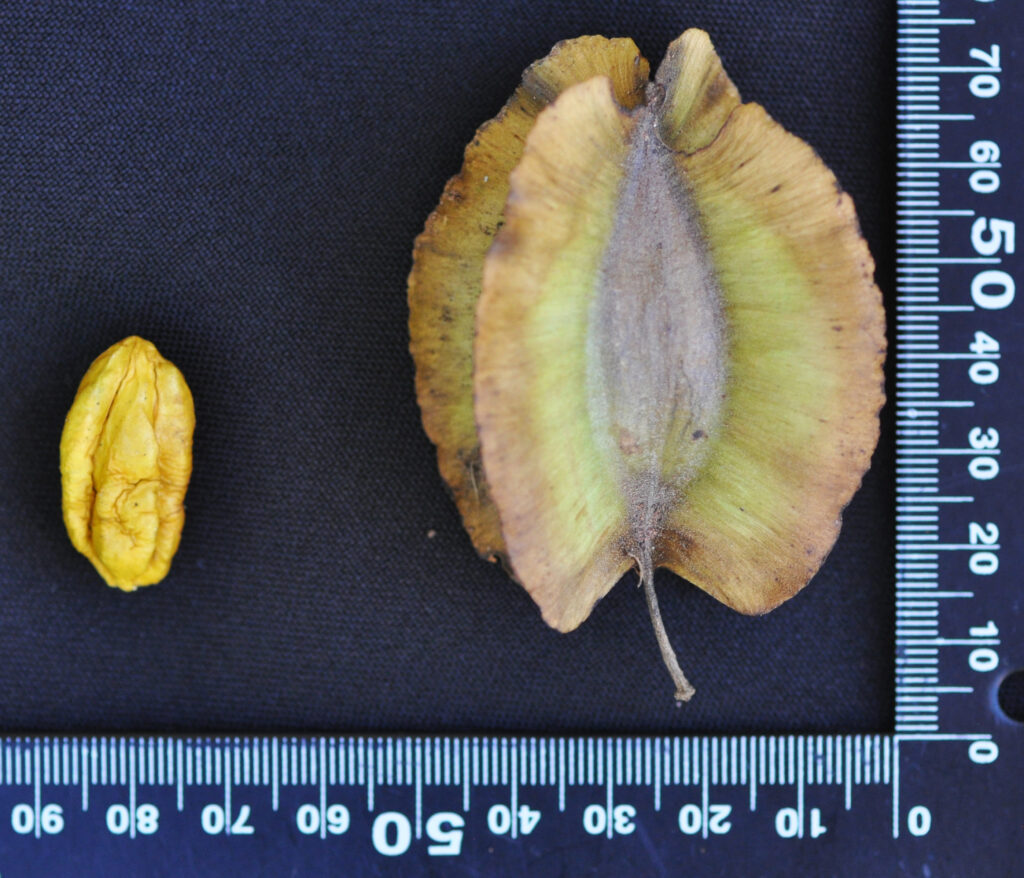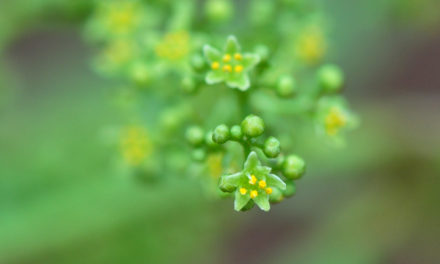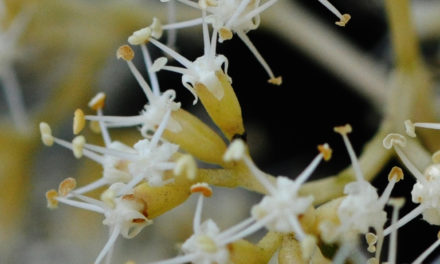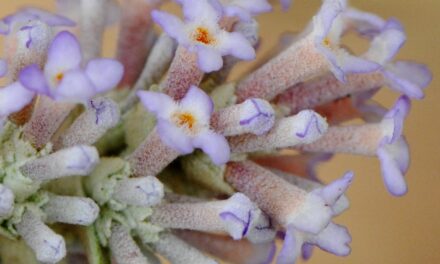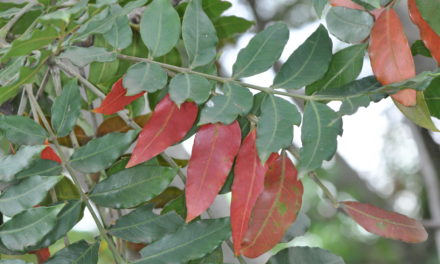General Info – Summary
This Tree is up to 15m high with a mottled stem. Simple, usually opposite Leaves have entire margins. Domatia may be present. The small, 4-merous bisexual Flowers are greenish yellow and in spikes. Each has 8 exserted stamens and the pistil has 1 inferior ovary that produces a slender, thin style. Fruit is a 4-winged samara with a single seed. This plant has the largest fruit and leaves in the genus Combretum.
Description
Previous Names: Combretum bragae, Combretum oblongum.
SA Tree No. 546.
Common names: (Afr) Blaasklapper, Fluisterboom, Kierie-klapper, Klapper, Klappers, Niklaasklapper, Nikolaas-klapper, Nicholas-klapper, Peulboom, Peulbos, Raasblaar, Raasbos, Raasklapper, Warmkos, Wurmhout. (Eng) Large-fruit Bushwillow, Large-fruited Bushwillow, Large-fruited Combretum, Zeyher’s Bushwillow. (siSwati) Immbondvo-lemhlophe, Imnbondvo-lemhlophe, Umbondo omhlophe. (Setswana) Modubana, Lesapo. (Northern Sotho) Moduba, Moduba-tshipi, Mokabi, Moluba. (Tshivenda) Mufhatela, Mufhatela-thundu. (isiZulu) Asembudwini, Umbondwe wasembudwini, Umbondwe-asembudwini, Umbondwe mhlophe, Umbondwe wasembundwini. (Xitsonga), Mphuba, Mafamba-a-borile, Mafambaborile.
Family: Combretaceae (Bushwlillow family). In this family, there are about 16 genera, which contain about 530 species. In South Africa, there are 5 genera and 41 species. Genera with Trees on this website include Combretum, Lumnitzera, Pteleopsis and Terminalia. The simple and usually entire Leaves lack stipules. Flowers are usually bisexual. There are usually twice the number of stamens as sepals or petals. The inferior Ovary has 1 locule and usually only 1 of the ovules develops into a seed. Fruit is usually indehiscent and may be winged or ridged.
Name derivation: Combretum – named by Pliny (AD 61-113) for a climbing plant. zeyheri – the first collector of this plant was Carl Ludwig Zeyher (1799-1858) in the Magaliesberg mountain range in 1835. The mountain range is mainly composed of quartzite (rock composed almost entirely of quartz. It is non-foliated and usually forms from the metamorphosis of sandstone). Carl Ludwig Zeyher also put together a descriptive account of some South African plants. Unfortunately, many of his collected specimens were lost.
Conservation: National Status: L C. (Least Concern). Assessed: Raimondo et al. (2009).
Tree
This Tree (photo 103) is seldom a shrub. It is graceful, spreading, and erect with a rounded crown. The plant may be single or multi-stemmed and can reach up to 15m high but is usually less than this. The possibly twisted trunk has a diameter of up to 38cm. The drooping (especially after fruit formation), light brown or grey Branches tend to be slender and occur low down on the trunk. Young branches have thickened Nodes (points on a stem where the buds, leaves, and branching twigs originate). The space between 2 nodes is the Internode. The trunk may be reddish (photo 98) or light brown to grey. The hairy young Stems are fairly smooth and have whitish Bark that becomes rough, flaking and mottled with age. Shed pieces of bark may reveal the reddish underbark (photo 98).
- 103. 2015/03/17. Borakalola NP. Photo: David Becking.
- 98. 2015/03/17. Borakalola NP. Photo: David Becking.
Leaves
The large deciduous Leaves are simple (have a single blade, which may have incisions that are not deep enough to divide the blade into leaflets). They are usually opposite (photo 92), but on young branches they may appear in whorls of 3. Leaves tend to develop in clusters towards the ends of branches. The leaf Shape is elliptic, oblong or obovate. Most of the Hair present on young leaves is lost and, apart from the main veins, the leathery adult leaves are almost hairless. Leaves may be the biggest of the indigenous Combretum genus range: (14) 9 x 5 (10) cm and may have a yellow tinge. In autumn, the leaves turn a yellowish to reddish colour and may remain on the tree until the emergence of new flowers. The Midrib and the 7-10 pairs of lateral veins (photo 95) and net veining are visible but are not deeply sunken above. Veins are clearly visible and slightly prominent below (photo 92). Here, hairy Domatia (occur in axils of principal side veins. To the naked eye, the domatia appear as small bumps. They are intended to be used by organisms that have a symbiotic relationship with the plant and are developed by plants to form a shelter for insects, fungi or mites) may be present. Domatia are visible if you carefully observe the upper side of the leaf (photo 95). Scales are present on the underside but are not visible to the naked eye. The bluntly pointed, rounded, flat or notched Apex may bend slightly upwards (photo 95). The Base is either narrowed or rounded. The Margin may be wavy (photo 95) and is entire (with a continuous margin, not in any way indented). The hairy Petiole (leaf stalk) is grooved on top has a slightly swollen base (photo 95) and is up to 1cm long.
- 92. 2015/03/17. Borakalola NP. Photo: David Becking.
- 95. 2015/03/17. Borakalola NP. Photo: David Becking.
Flowers
The densely arranged, small, and bisexual Flowers are in groups of axillary (growing between stem and leaf) Spikes (simple indeterminate inflorescence with sessile flowers on a single unbranched stalk) with a tomentose (covered with densely matted woolly hairs) peduncle (stalk of flower cluster). These spikes are up to 8cm long and flowers usually appear before or with the new leaves. They are impressive when in profusion. Each flower is white to greenish-yellow with a red centre and is 4-merous (-merous – having a specific number of parts). Individual flowers have 4 Sepals in the Calyx. There are 4 yellow triangular Petals in the Corolla that are obovate to triangular and small – up to 2,5mm long. The 8 orange Anthers are dorsifixed and versatile (hung or attached near the middle, and usually moving freely). There is a single Pistil (a unit of the Gynoecium, the female element of the flower, composed of the Ovary, Style and Stigma). The pistil contains an inferior Ovary with a long slender, free Style. (Aug-Nov and occasionally to Jan).
Fruit
The large, stiff and shiny Fruit is a samara (a simple dry, indehiscent winged fruit. Each wing is papery and develops from the ovary wall). In this plant the 4 papery wings (photo 100) are initially green and turn a light golden brown (photo 99) and finally dark brown (photo 371). This fruit is the Largest of the indigenous members of the Combretum genus – reaching up to 10 x 7cm and is diagnostic. Each fruit contains a single Seed (photo 369). Although they are individually of low density for dispersal, the fruit occurs in such large numbers that they cause the branches to bend. The fruit makes an easy to hear rustling noise in the wind – especially in winter when the leaves have fallen. (Dec-Oct).
- 100. 2015/03/17. Borakalola NP. Photo: David Becking.
- 99. 2015/03/17. Borakalola NP. Photo: David Becking.
- 371. 2018/04/24. Nylsvley NR. Photo: David Becking.
- 369. 2018/04/24. Nylsvley NR. Photo: David Becking.
Distribution & Ecology
These good shade trees grow in the African savanna (a rolling grassland scattered with shrubs and isolated trees, which can be found between a tropical rainforest and desert biome) and are not endemic to South Africa. They often grow on almost any soil, including sand dunes, rocky hillsides and poor acidic soils. These plants occur naturally in KwaZulu-Natal, Gauteng, Mpumalanga e.g., western bank of Blyder River, Limpopo, and North West. Beyond South Africa they occur naturally in Eswatini (Swaziland), Mozambique (mainly central and north), Botswana, Zimbabwe, Zambia, Namibia and northwards), on stony hill slopes and at medium to low altitudes and in summer rainfall areas. The trees are drought resistant and considered to be an indication of sour veld, that is largely covered with coarse seasonal perennial grasses and affords inferior grazing and acid veld. They often grow with Combretum molle, Burkea africana and Vachellia (Acacia) robusta. The Flowers attract bees. Giraffe may consume the Leaves. Hornbills break the fruit and eat the single Seed. Butterfly larvae of the Apricot Playboy Deudorix dinochares feed on this Fruit and that of “Acacia”, Gardenia, Burkea africana and many others. The male upper wings are largely orange, and the female wings are a greenish yellow.
Ethnobotany
The Wood is yellowish-white and, like Celtis africana (white stinkwood), it may have an unpleasant smell when cut. When dry, the wood works well and is a good all-round timber, which is durable if thoroughly seasoned. The wood is used for making yokes (a wooden crosspiece that is fastened over the necks of two animals and attached to the plough or cart that they are to pull). Necklaces for girl’s initiation are made from surface Roots. The fibrous roots are also used for making baskets and fishing traps e.g. in Namibia). The roots are normally beige and are sometimes dyed grey or dark by using bark from Pterocarpus angolensis (kiaat) or from Burkea africana. Gum is edible and has some antibiotic properties. Bark ash solution is used for straightening hair. Leaf extracts have an anti-fungal component. Leaves and fruit make a distinctive rustling sound in strong wind (raasblaar in Afrikaans). Fresh clean seeds removed from mature fruit will grow after soaking overnight in water. The young plant is drought and severe frost sensitive and grows best in full sun. Do not over water the young plants. They will grow about 0,8m per year. For shade, the lower branches may need pruning. This tree provides a nesting site for birds. Plant parts are used for local medicine.
References
Boon, R. 2010. Pooley’s Trees of eastern South Africa. Flora and Fauna Publications Trust, Durban.
Burrows, J.E., Burrows, S.M., Lotter, M.C. & Schmidt, E. 2018. Trees and Shrubs Mozambique. Publishing Print Matters (Pty) Ltd. Noordhoek, Cape Town.
Coates Palgrave, M. 2002. Keith Coates Palgrave Trees of Southern Africa, edn 3. Struik, Cape Town.
Foden, W. & Potter, L. 2005. Combretum zeyheri Sond. National Assessment: Red List of South African Plants version . Accessed on 2025/01/09.
Lawrence, G. H. M, 1951. Taxonomy of Vascular Plants. The Macmillan Company, New York. Tenth Printing 1965.
Palmer, E. & Pitman, N. 1972. Trees of southern Africa. Balkema, Amsterdam, Cape Town.
Schmidt, S. Lotter, M. & McCleland, W. 2002. Trees and Shrubs of Mpumalanga and the Kruger National Park. Jacana, Johannesburg.
van Wyk, B. & van Wyk, P. 1997 Field guide to Trees of Southern Africa. Struik, Cape Town.
http://pza.sanbi.org/combretum-zeyheri
http://operationwildflower.org.za/index.php/plant-records/trees/150-combretum-zeyheri
http://pza.sanbi.org/combretum-zeyheri
http://www.krugerpark.co.za/africa_bushwillow.html
http://www.zimbabweflora.co.zw/speciesdata/species.php?species_id=142090
http://posa.sanbi.org/flora/browse.php?src=SP
“Domatium.” Merriam-Webster.com Dictionary, Merriam-Webster, https://www.merriam-webster.com/dictionary/domatium. Accessed 8 Jan. 2023.

